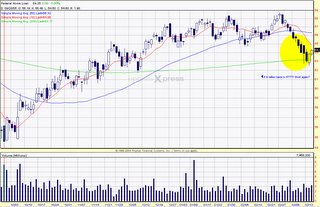I have decided to get the boring, but most important part of this year's speculation game out of the way first. The development of the trading system - or perhaps more correctly phrased - "money management system" has not been easy. The system will require refinement and adaptation as it is applied, but I must have some type of rule based method or I will be unable to make the tough call when it arrives on my own free will.
Here are the key rules for my system. The rules will adapt to a long or short position and use leverage as part of the money management function. The stricter rules will not only require me to closely follow the system, but they will also force adaptation of my entire trading approach. I will have to pick entry and exit points more carefully now as I will be aware that if I do not pick a good starting point I may be quickly shaken out of my position and forced to take the 10% loss - unable to wait for the price pattern to collect itself.
The system's success or failure will only be measured at the end of year by looking at the bottom line and the number of successful trades v. failed trades. If I look at last year's trades I let several positions - gold and financials decline in value to zero. Even a 50% stop loss system would have likely saved close to $2,000 and would have clearly influenced the year's results for the better.
So, enough reminiscing and back to the system and its requirements:
1) Stop-loss rule.
/ Decrease in stock price of (10% X the amount of leverage in the position) and position is sold /
Pure stock trades have 1.0 as the amount of leverage, whereas options trades will contain the leverage component which can be measured by dividing the total value of the position in theory (total number of shares controlled via options X market price) by the current position value.
The measuring point for the 10% is the initial entry point. If the trade goes against me the 10% will be the automatic sale point. If the position is successful the 10% will be used from the peak price point. This should work quite in well theory, because as the position increases in value the amount of leverage should also decrease.
Major advantages of the stop-loss component. Forces me to admit I was wrong and take losses at some point. Major disadvantages - its components especially the leverage aspect may be too loose and force me to liquidate certain positions too late. Example - if I have taken on 10X leverage or more in the position - I will be wiped out before the stock itself declines 10%. If I find this to be a problem in practice I may reduce the stop-loss % for options trades to 5% from entry point or I may find some other technique.
2) Profit-taking rule.
/ Take one-third of profits at 100% gain in position. Allow additional two-thirds profits to run subject to application of the stop-loss rule. /
This rules speaks for itself I think. It may need to be modified or broken down into two parts if experience later requires. There are really three considerations. One is - time frame - or when to take the profit. The second is - amount - how much profit to take. The third - is price - or is there a certain price level or target that would require the position to be liquidated. I think the current rule will deal with all of these considerations sufficiently for now.
3) Position-sizing rule.
/ Never place (initially at trade outset) more than 20% of the portfolio at risk. This means starting out with the account equity of 10K I cannot risk more than 2K at one time. /
This rule is to prevent meltdowns like last fall - there is no major reason to have more than 20% of capital at risk as with options leverage that I am using on average 5X-10X leverage the effect is that a successful trade can give the result of having my entire portfolio invested, while the downside is protected and limited to the position size.
Conclusions
The system is deceptively simple. I expect its application to prove difficult in practice however because I will have to follow the rules! :)
Now that the hard stuff is out of the way I will discuss the two themes of this year's speculations. The time horizons that are associated with the speculations and also the individual securities that I will be trading to execute on those themes and expectations.
This is the interesting part as we get to bullshit about the expected future course of the economy. I have realized that in practice this is what I really enjoy most about investing / trading - however, without the money management component I will meet my end too soon and be unable to continue. Let's stick to the system and refine it throughout the course of the year.
Best regards,
BG

 Regards,
Regards,![[Most Recent Quotes from www.kitco.com]](http://www.kitconet.com/images/live/s_gold.gif)
![[Most Recent Quotes from www.kitco.com]](http://www.kitconet.com/images/live/s_silv.gif)
























